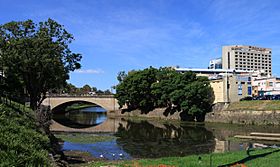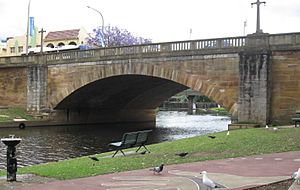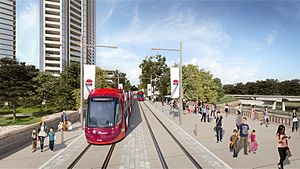Lennox Bridge, Parramatta facts for kids
Quick facts for kids Lennox Bridge |
|
|---|---|

The Lennox Bridge in Parramatta, from the west.
|
|
| Coordinates | 33°48′39″S 151°00′16″E / 33.810719°S 151.004548°E |
| Carries | Church Street, Parramatta
|
| Crosses | Parramatta River |
| Locale | Parramatta, Western Sydney, New South Wales, Australia |
| Named for | David Lennox |
| Owner | Parramatta City Council |
| Preceded by | Gaol Bridge (1804-1836) |
| Characteristics | |
| Design | Single arch bridge |
| Material | Hawkesbury sandstone |
| Total length | 27 metres (90 ft) |
| Width | 9.1 metres (30 ft) |
| Longest span | 23 metres (76 ft) |
| Number of spans | 1 |
| History | |
| Designer | David Lennox |
| Construction begin | 22 October 1836 |
| Construction end | 1839 |
| Construction cost | £1,797 |
| Type | Built |
| Criteria | a., e., f. |
| Designated | 2 April 1999 |
| Reference no. | 00750 |
| Lua error in Module:Location_map at line 420: attempt to index field 'wikibase' (a nil value). | |
The Lennox Bridge is a very old and important bridge in Parramatta, a suburb in Sydney, New South Wales, Australia. It's made of strong sandstone and crosses the Parramatta River.
This bridge was designed by David Lennox, who was the first person in charge of bridges for the early colony of New South Wales. It was built between 1836 and 1839 using the hard work of convicts.
Lennox Bridge is one of the oldest stone bridges still standing in New South Wales. It carries Church Street, which is a main road in Parramatta's city centre. Because of its history, it was added to the New South Wales State Heritage Register on 2 April 1999.
Contents
History of Lennox Bridge

The Lennox Bridge stands where people have crossed the Parramatta River for a very long time, right from the early days of the colony. The bridge you see today is actually the third one built on or near this spot.
The first bridge was a simple wooden walkway. Sadly, floods destroyed it in 1795. The second bridge, known as the Gaol Bridge, was built with stone supports and wooden railings. It was finished between 1802 and 1804.
The current Lennox Bridge is a single-arch bridge made from sandstone. This stone came from a quarry near the Parramatta Female Factory. It was completed in 1839 and cost about £1,797, which was a lot of money back then!
David Lennox's Bridges
This bridge was the third and last one designed by David Lennox. His first two famous bridges were:
- The Lennox Bridge at Glenbrook, finished in 1833. This is the second-oldest bridge on the Australian mainland.
- The Lansdowne Bridge at Lansvale, finished in 1836.
Changes Over Time
Over the years, the Lennox Bridge has been changed to handle more people and traffic:
- In 1885-86, one side of the bridge was widened, and new railings were added.
- Around 1901-02, the bridge was made stronger inside to support the Castle Hill Tramway.
- In 1912, a part of the side wall was removed to create a path for people to walk on.
- Then, in 1934-35, this new section was removed. The bridge was widened again to cope with even more cars. This change made the western side of the bridge straighter.
In the 1990s, there were plans to knock down Lennox Bridge. However, the National Trust of Australia (NSW) worked hard to save it, and they succeeded!
Bridge Design and Structure
Lennox Bridge is a single sandstone arch bridge. It stretches 91 feet (about 27.73 meters) across the Parramatta River. The main arch itself spans 23.16 meters. It is part of Church Street.
Tunnels for Pedestrians and Cyclists
In 2012, a plan was approved to build tunnels through the bridge on both sides of the riverbanks. These tunnels were for people walking and riding bikes. Work started in early 2014.
There was a delay because workers found old stone supports and wooden beams from the second bridge (built between 1802 and 1804). Both tunnels opened in 2015.
Currently, the southern tunnel is closed. This is to help with the building of the Parramatta Light Rail and a new apartment building called The Lennox. The apartment building will include a new public walkway.
Parramatta Light Rail Project
In 2019, construction began on the Parramatta Light Rail (Stage One). This big project will connect Westmead to Carlingford, passing through the Parramatta city centre. It will be a 12-kilometre track and is expected to open in 2023.
As part of this project, Church Street (including Lennox Bridge) will become a special zone for light rail, pedestrians, and emergency vehicles only. This means regular cars will not be able to drive across the bridge. The historic bridge itself will be kept and used for the light rail.
Why Lennox Bridge is Important
Lennox Bridge is one of Parramatta's most important historical buildings. It is also one of the earliest bridges built in New South Wales and Australia. It shows the amazing work of the famous engineer David Lennox.
The bridge helps us understand how Parramatta developed as a town a long time ago. It is important for both its history and its engineering design. It is also quite rare to find such an old bridge still standing.
Lennox Bridge, Parramatta, was officially added to the New South Wales State Heritage Register on 2 April 1999. This means it is protected and recognised as a significant part of our heritage.


